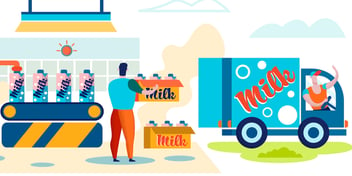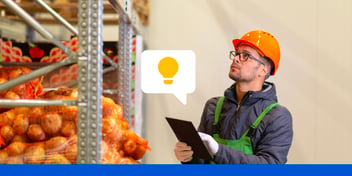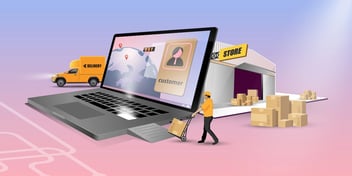There’s no doubt that food and beverage logistics companies operate in some of the most competitive markets out there. Even before the pandemic, grocery stores, schools, restaurants, and other accounts could be unforgiving when it came to late deliveries. Delivering on-time and meeting complex sets of customer requirements is difficult under the best of circumstances—and now that supply chain conditions have become more volatile and demand is less predictable, consistently getting the right goods to the right place at the right time is harder than ever.
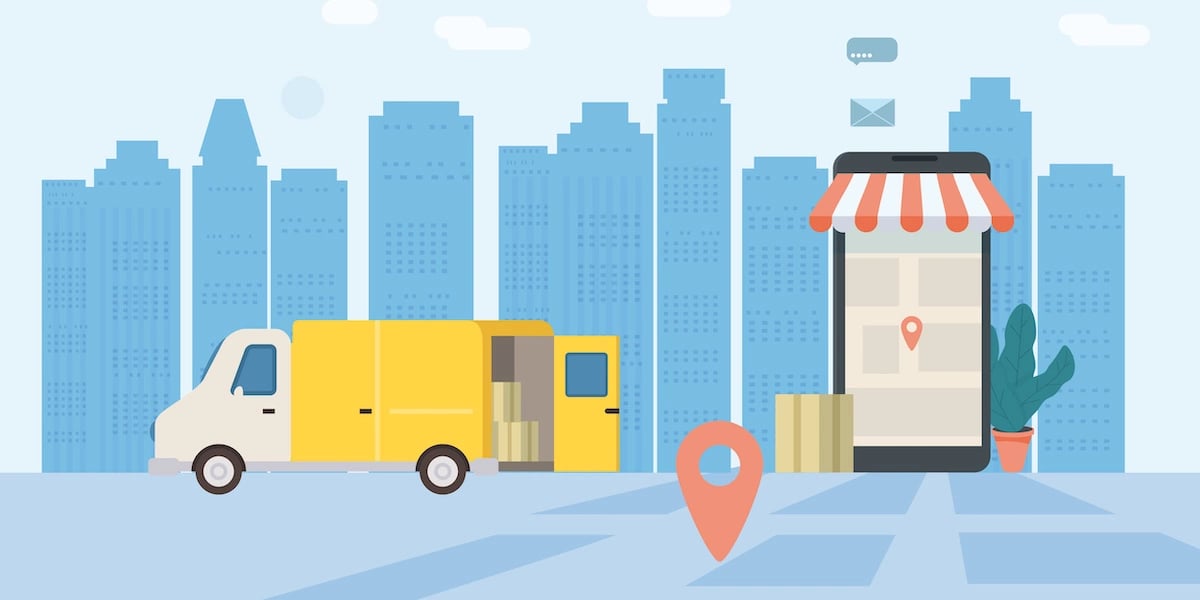 When it comes to dealing with pandemic-based uncertainty, changing customer expectations, and greater competition than ever before, many of the old ways of doing things just don’t cut it. Planning out routes with pen and ink, distributing physical work orders to merchandisers, and other legacy approaches can be incredibly inefficient in terms of time. More than that, they provide you (and your customers) with little to no transparency over deliveries. This means that your sales reps don’t know which accounts need some extra attention, and your customers don’t know if that day's shipment of tomatoes (or cabbages, or kegs of beer, etc.) is going to be there when they need it.
When it comes to dealing with pandemic-based uncertainty, changing customer expectations, and greater competition than ever before, many of the old ways of doing things just don’t cut it. Planning out routes with pen and ink, distributing physical work orders to merchandisers, and other legacy approaches can be incredibly inefficient in terms of time. More than that, they provide you (and your customers) with little to no transparency over deliveries. This means that your sales reps don’t know which accounts need some extra attention, and your customers don’t know if that day's shipment of tomatoes (or cabbages, or kegs of beer, etc.) is going to be there when they need it.
We’re living in a new era with new challenges and opportunities—and food and beverage distributors need new tools and strategies to grapple with them. This is why digitization in food and beverage distribution is so important at this exact moment.
1. Keep Customer Experience in the Foreground
Digitization in any industry is about technology and process—but, in food and beverage distribution especially, it’s also about people. That’s why it’s so important to keep people front and center when you’re making decisions about which technologies to adopt and which processes to update. Specifically, you need to keep the needs of your customers in mind at every step of the process, which means going out of your way to ensure that any new technology is compatible with empowering right-time deliveries.
By using customer experience and right-time delivery performance—i.e. getting the right goods to your customer, right when they expect them—as guiding principles, you can set yourself up to avoid technology that makes it hard to accommodate specific customer requests. You can also avoid technology that doesn’t enable easy coordination between sales, delivery, and merchandising. Most importantly, you can avoid technology that doesn’t help you maximize the use of your capacity while ensuring that customers always get their orders at the right time.
2. Leverage SaaS Technology to Future Proof Your Processes
One of the reasons that digitization is having its moment right now is that the promise of “future-proof” technology is becoming more than just a buzzword. With on-prem technology, and even with some cloud solutions, extensive maintenance needs and complex interoperability requirements mean whatever solution you adopt is already heading down the path to obsolescence from the moment you deploy it.
With SaaS technology, the opposite is true: The burden of keeping the technology up-to-date falls on the provider, which means that you can be sure that you’re always using the latest version of the software. This significantly decreases the odds that you’re going to run into compatibility issues down the road with other enterprise software systems. This leaves you free to focus on your customers and their delivery needs, instead of constantly fussing with your food and beverage logistics technology.
.png?width=1501&height=501&name=image%20(6).png)
3. Integrate Technology to Keep Silos Off the Menu
One of the reasons that complex processes like food and beverage distribution are such a good fit for digitization is that both succeed on the strength of connectivity. When your logistics workflows are firing on all cylinders, sales is connected to delivery and merchandising in a seamless way that ensures customer satisfaction. And digitized delivery management processes should provide for exactly the same—which is why it’s so important to strive for technology integration and avoid creating data or decision-making silos.
In practice, this means looking out for delivery management solutions that can easily connect to your warehouse management, route accounting, ERP, telematics, and other software solutions. By providing bi-directional data flows between different solutions, you can make sure that everyone’s working from the most up-to-date data. When everyone’s singing out of the same songbook, you can stay agile and ensure right-time delivery management from end to end.
4. Leverage Hybrid Route Optimization for More Flexible Food and Beverage Logistics
We’ve talked a bit about ensuring delivery efficiency without sacrificing the need to hit customer time windows. As anyone in food or beverage distribution knows, this is no mean feat. The most common scenario for many distributors is that huge amounts of buffer time are built in between stops to ensure on-time deliveries to the most important accounts. This means that drivers are either sitting idle during a large portion of the day or they’re off on frolics of their own. When it comes time to add a new account or accommodate a last-minute order, it’s tough to tell how much flexibility exists within that buffer.
Taking this kind of conservative approach to meeting ETAs obviously means that you can’t make the most efficient use of your capacity. When margins are razor-thin to begin with, this puts distributors in a bit of a bind: how do you increase efficiency and complete more stops per route without jeopardizing the on-time deliveries that are so crucial to keeping customers happy?
The answer lies in the right approach to digitized delivery routing. Most of the route optimization options out there tout their dynamic route planning capabilities—but when your customer relationships depend on recurring stops and orders, starting a new route plan from scratch every day doesn’t make much sense. At the same time, these same static routes are making it impossible to stay agile and make adjustments to your plans as new conditions emerge. Simply put, you need a hybrid approach. You can start with optimized static route plans for your most important customers, and then leverage dynamic routing capabilities to slot smaller customers or last minute orders in around your larger “anchor stops.” In this way, you can actually leverage all of your existing capacity while maintaining great customer relationships based on consistent right-time delivery.
5. Let AI Power Perfect Right-Time Delivery Performance
Like we saw above, one of the reasons that it’s so difficult to maximize efficiency in food and beverage logistics is that it feels like you need to build in buffer time between stops. We’ve seen how a hybrid approach to route optimization can help—but to really know how much capacity you have, you need incredibly precise estimates for how long the driver will spend driving between stops and then actually unloading at the delivery site. If you can’t confidently say what time the driver should arrive at each stop, you can’t be sure that you’re not over- or under-utilizing your vehicle capacity. In other words, precious ETA estimates are a must.
This is where AI comes in. By analyzing historical data from across your logistics operations—including service times and regional traffic patterns—AI can generate ETA predictions that are significantly more accurate than a human planner could possibly pull off. It can even provide live ETA updates as real-time data comes in on the day of delivery. In this way, you can get the most out of your hybrid routing approach—and your capacity.
At the end of the day, this is why digitization can be so powerful for food and beverage distributors. Without a robust digital approach based on AI and cloud-technology, consistent right-time deliveries can be a challenge—but with the right tools and technology, you can keep your customers happy without sacrificing efficiency.
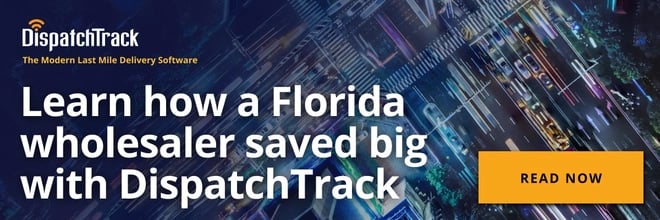
 When it comes to dealing with pandemic-based uncertainty, changing customer expectations, and greater competition than ever before, many of the old ways of doing things just don’t cut it. Planning out routes with pen and ink, distributing physical work orders to merchandisers, and other legacy approaches can be incredibly inefficient in terms of time. More than that, they provide you (and your customers) with little to no transparency over deliveries. This means that your sales reps don’t know which accounts need some extra attention, and your customers don’t know if that day's shipment of tomatoes (or cabbages, or kegs of beer, etc.) is going to be there when they need it.
When it comes to dealing with pandemic-based uncertainty, changing customer expectations, and greater competition than ever before, many of the old ways of doing things just don’t cut it. Planning out routes with pen and ink, distributing physical work orders to merchandisers, and other legacy approaches can be incredibly inefficient in terms of time. More than that, they provide you (and your customers) with little to no transparency over deliveries. This means that your sales reps don’t know which accounts need some extra attention, and your customers don’t know if that day's shipment of tomatoes (or cabbages, or kegs of beer, etc.) is going to be there when they need it..png?width=1501&height=501&name=image%20(6).png)


